
If you need a freelance travel writer or you would like to see your country, city, flight, etc., presented on the blog, drop me an email.
Find our more on Freelance Travel Writer page.
If you are yearningly looking at Andalusia photos, you will definitely need this Arcos de la Frontera Spain Things to do post, since this is the famous white village. As one of the most impressive “pueblos blancos” in Spain, it is located in Cadiz province where it almost hangs from a cliff!
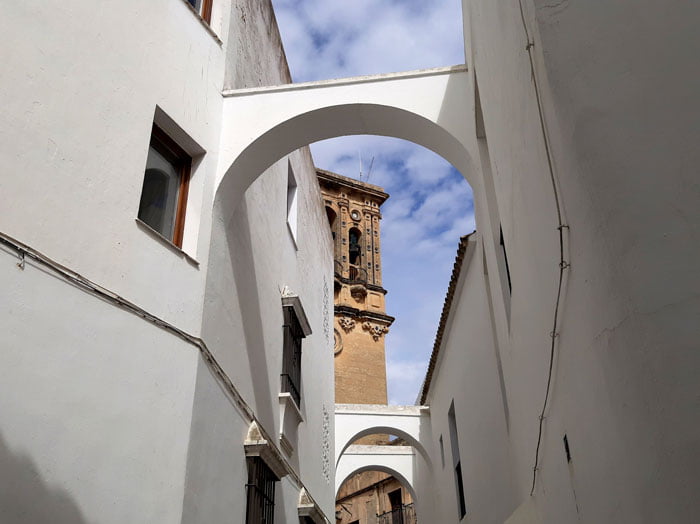
WHITE VILLAGES SPAIN
The whitewashed villages of Andalusia Spain are impressive historical monuments where people live according to their old Iberian, Roman and Moorish traditions. Many of them are situated along the coast and have now become fashionable resorts, conserving the ancient charm, while others are even more authentic, hidden in the highlands of southern Spain.
Most Andalusian towns were built around fortresses and they stood in Cadiz province along the border between Moorish and Christian kingdoms. (Hence the reason for “de la frontera” or “of the border” extension in their names – Jerez de la Frontera, Moron de la Frontera, etc.) Many of these settlements have developed over time into agricultural centers by producing olive oil, fruit and vegetables, and goat’s milk.

The rugged hills Sierra de Cadiz at the very south of Spain hide numerous whitewashed villages, located on top of rocky cliffs. They are easy to spot given that all the houses are painted in white, separated by narrow, curvy streets, almost too small for a single vehicle to pass through. These “pueblos blancos” often had an important defensive function during the 13th and 15th centuries, and it is easy to notice nowadays a brownish fortification or a large church among those white walls.

If you are traveling across Andalusia from one town to another, as I did, there will be lots of these villages to see along the way. Among endless olive grows there will be a solitary hill densely packed with whitewashed houses alluring you from the top. Just as half of a white hive was put onto a lavish grass. Due to the lush nature surrounding them, these settlements seem as being extremely white.
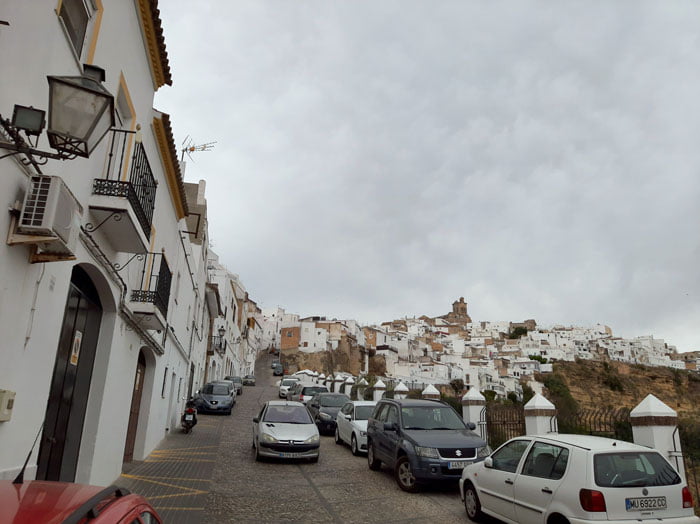
A few of these should be mentioned when traveling through the region – Zuheros in Cordoba province, Machena near Seville, Frigiliana in the area of Malaga, but also spectacular Ronda (more about it next time), Salobrenja in Granada province or Mojacar in Almeria. As for me, I have decided not just to visit Arcos de la Frontera, but to spend a few days here.

ARCOS DE LA FRONTERA SPAIN
This is one of the most dramatically positioned white villages Spain, representing a fine balance between the rocky limestone ridge, whitewashed houses and a stone castle walls, cut abruptly by a cliff. It is surrounded by Guadalete river from three sides. Due to its exceptional architecture and fascinating location, Arcos was declared a national historic-artistic monument in 1962. Although it really flourished under Moors, archaeological remains show that the town was always popular among invaders, ever since the Neolithic period, given that it has a superb defensive location and plentiful waters.
Arcos is inhabited by 28,000 people who live in lower slopes of the settlement and in the old town on the top.

I was almost more excited to spend a night in the white village and about Arcos de la Frontera things to do, than to sleep in Granada I visited two weeks earlier. It was convenient to take the bus from Cadiz to Arcos (Spaniards would pronounce it “Arko”), the ticket was about 9 Euros.
TIP: The best way to purchase bus tickets to and from small towns is to buy them online. Otherwise, it might happen (as it did in Arcos), that the bus station office doesn’t work. If you do it online, you will be able to find itineraries and check prices.
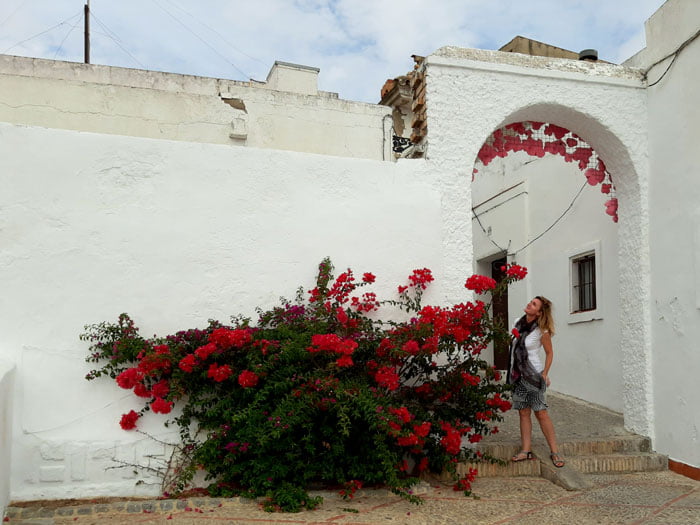
In less than an hour and a half, we were driving up the hill, where the town stood alluring us from afar. And there, I already reached the small station.
My accommodation was at the Andalusian house in the center of the old town, about half an hour’s walking distance up the hill. The landlady recommended taking a microbus with the label “centro” (still not sure if it could fit more than 10 people). It was already crowded when it got here.
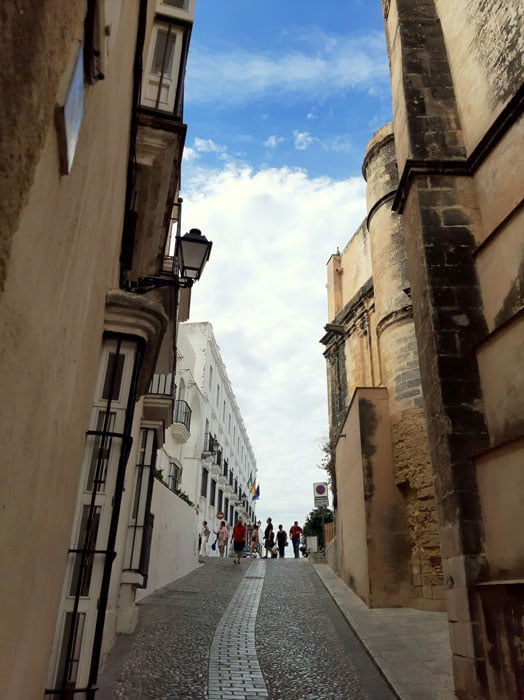
Took one step inside – a young driver wearing sunglasses and about a dozen elderly Spanish ladies immediately turned their heads, staring at me from head to toe. The microbus had a low ceiling, so I had to bend a bit, holding my bag in front and trying to read the address from my phone. (No one spoke English, of course!)

As soon as I said where I was going, a dozen “Si, si!” squawked from the bus creating a vivid discussion (about my destination, I would say), while their hands were showing me to find the seat in the back. I managed to squeeze in between the two ladies and continued to nod, while the microbus was going upwards (as though it was going to flip from the nose up), and all those ladies were still chatting vividly and talking to (or about) me, all at once. Finally, they took me by the hand and took me outside… (Again! Remember Seville?)
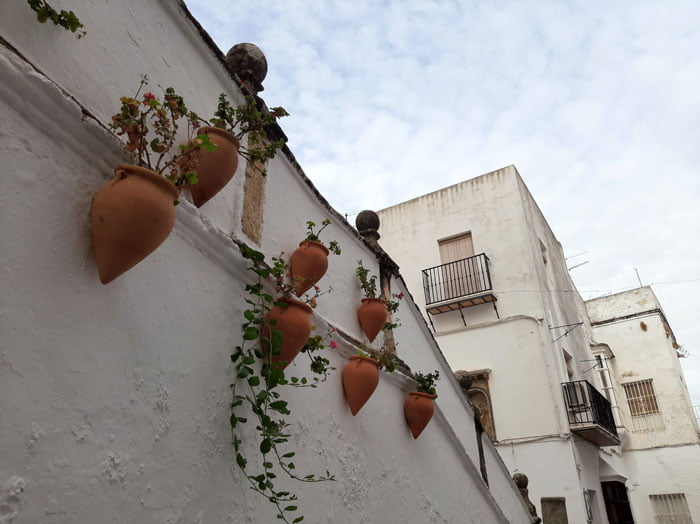
TIP: Bus tickets can be purchased at main stations in larger tows from the counter or machines, but not for departures from other towns. I was recommended in Seville that I should get a ticket from Cadiz to Arcos when I get to the Cadiz station. Still, it was easier to do it in advance and online.
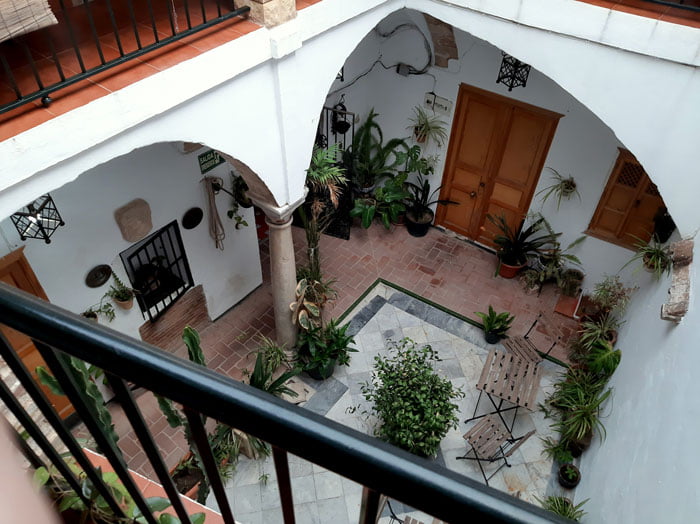
The accommodation was just right with the room on the first floor, and I could just sit there by the window for hours. When I took a glance outside in the morning, I couldn’t wait to get out and explore my white village! My window view spread over the rooftops all the way to the lake.
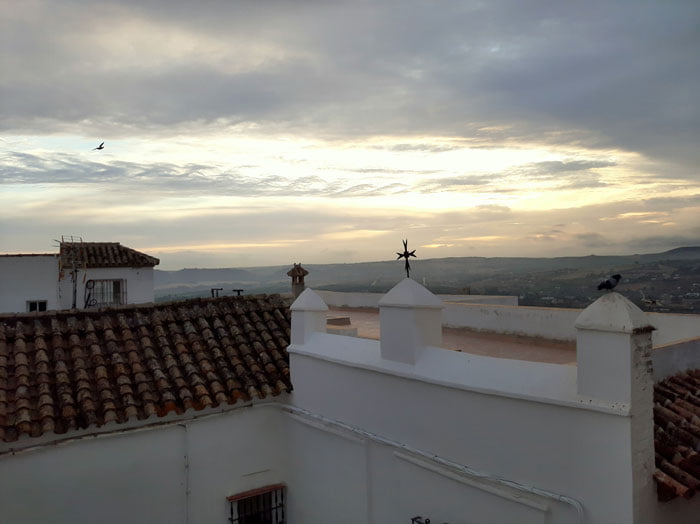
PLAZA DEL CABILDO
The small central square is famous for housing the Town Hall, the castle, the dominant Santa Maria de la Asuncion Church, and the viewpoint. This is also where the parking is, while the view reaches the surrounding valley down the 150-meter-high cliff.
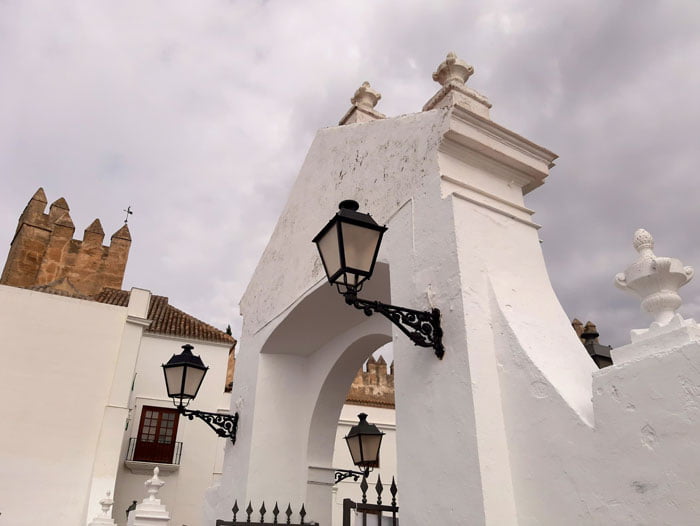
When you go along Cuesta Belen Street from the lower town, eventually the church is to be reached, located in the very center. Maps are available at the Tourism Information Office in Arcos, where I was also told just to go straight, „because all there is to be seen is located in that direction“. (It’s not really possible not to wander astray from time to time, exploring those charming narrow streets. I took a few strolls as such and got lost each time! It was even easier to walk all around the village at one point because I knew I would be lost again if I only stepped into another one of those curvy pathways.)
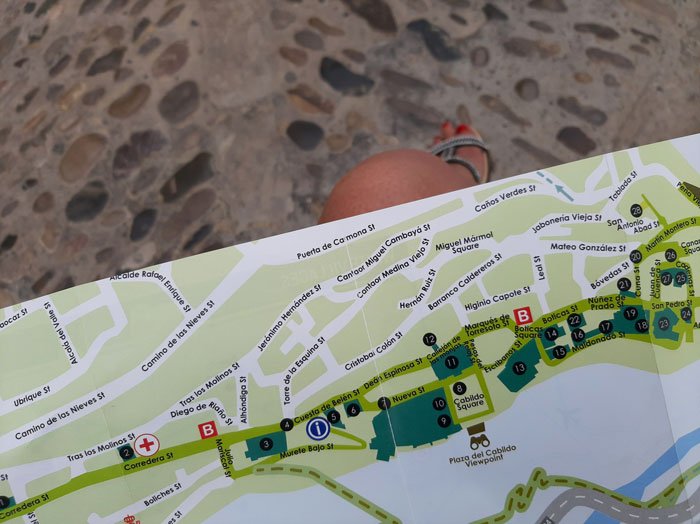
This is the square to admire 18th-century charming façades or to have a coffee on the hotel terrace with a view of the cliffs. One can also gaze at the river banks below with olive and orange grows.

The Town Hall was moved here in 1634. The stone façade with the statue of Archangel Michael, the patron of Arcos, dates back to the 17th century. They say that it is home to a few important paintings.
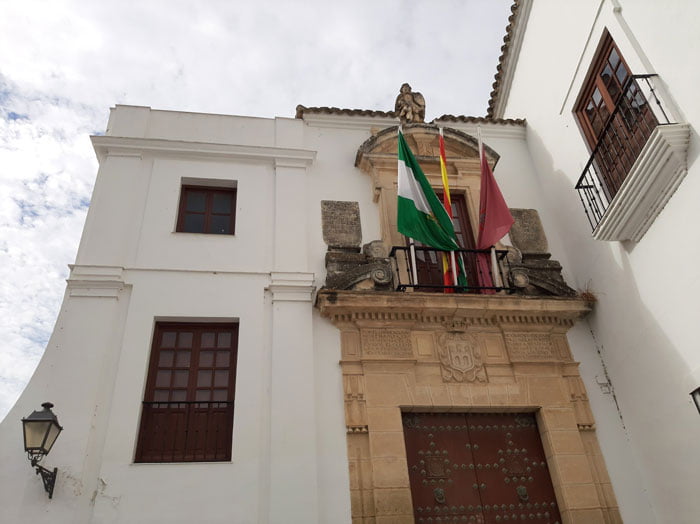
There is also a New Street to see nearby, even though it’s a few centuries old. This is actually where the old castle moat stood which was destroyed by the 1755 Lisbon earthquake, along with the northern fortress’ wall. So, the new street sprung up with the arch built at the end of the 17th century.

DUCAL CASTLE
The castle is rectagonal with four towers on its corners. The Moors built a military fort here in the 11th century while Arcos was briefly a taifa (small kingdom). The Christians rebuilt the castle as an important hold of the town in the 14th and the 15th century, strategically positioned between the two kingdoms. It is now privately owned, bearing the shield of the Duke of Arcos on its façade.
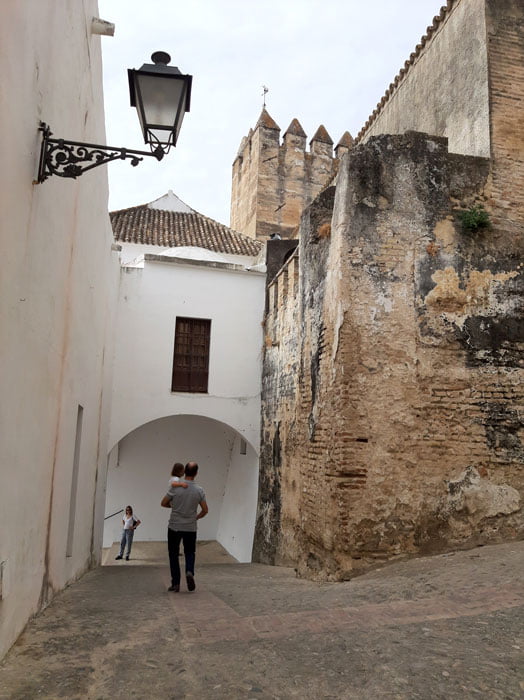
I have to admit that I was a bit disappointed by the fact that the castle was not to be entered. One might expect crowds at the entrance only to find out that it was a private property restricted for visitors. A small cobbled passageway next to the Town Hall with arches above tickled my imagination even more.
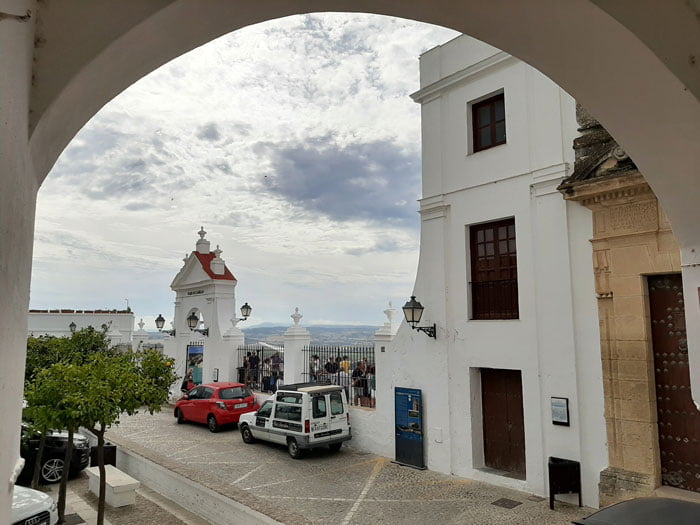
Nevertheless, the square is to be visited first and foremost because of the viewpoint (“mirador” in Spanish). It comes as a surprise that there are so many cars parked here, but when you think about it, they need to go somewhere (while you try to avoid them by jumping into doorposts in those small streets). The “real” parking lot is only available in the lower town because it’s hard even to drive properly here (without scratching both of your side mirrors). Still, my view here was only spoiled by a few white clouds, covering the Arcos sky those days (even though it was the end of September with 27 degrees Celsius). They were the reason everything looked even more mystical, tucked in a mist.
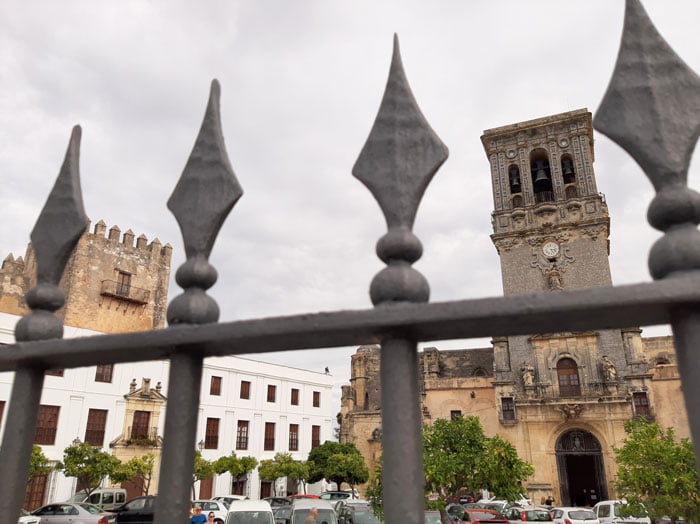
THE MAIN CHURCH
The parish church Santa Maria de la Asuncion was declared a national monument in 1931 and it is constructed on the site of the old Arab mosque. It is interesting that it was built for six centuries which led to a mixture of styles, accompanied by lots of artists who worked on it. The main façade displays the Gothic and the Spanish Plateresque style.
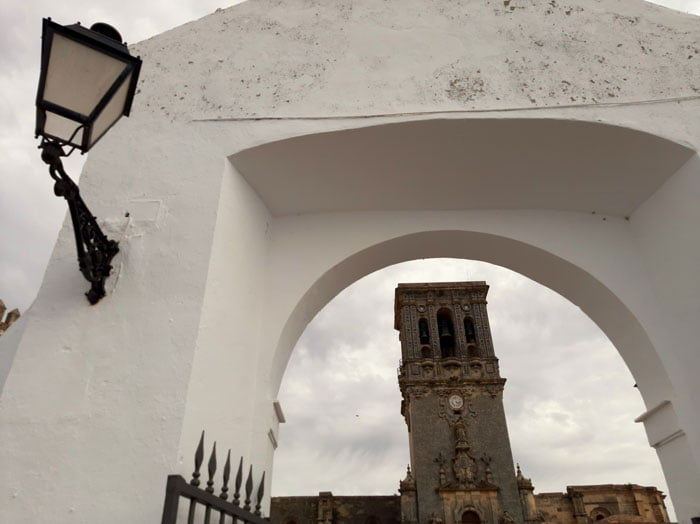
This church will make you sigh. Its high bell tower is to be admired from the plaza, but you can also see it from the side, with the decorative doorway and lots of façade details, and from the back, with the tall passage arch leaning on the houses on the other side. This is where cars drive through, along the town’s central street, and if you see one, make sure to step away – there’s no room for both of you to squeeze through.
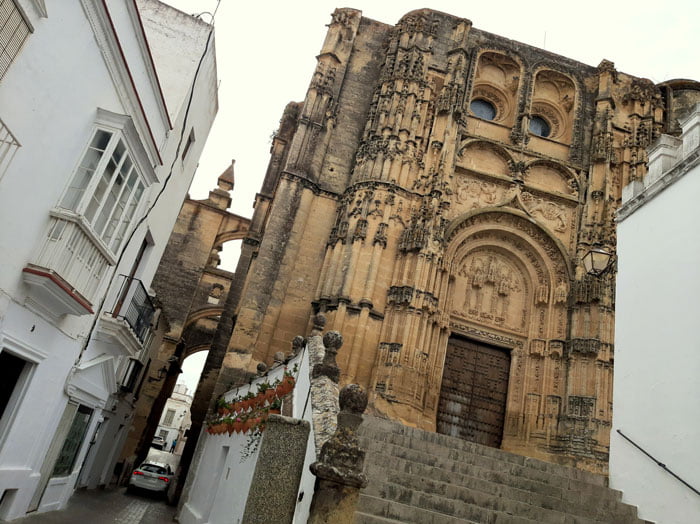
Further down this street, there are monastery brotherhoods buildings to be seen, but local shops and restaurants as well. If you happen to turn below the white arches in the right direction, you might come out to the always crowded small square. Whitewashed walls, some flowers from the windows, cobblestone streets… And you always promise yourself “you will surely come back here later”, but the square would almost be impossible to find again.

One of the most important Arcos de la Frontera Spain things to do should certainly be to have lunch or dinner at one of the street terraces. Tables for two are squeezed against the restaurant walls, so that when you sit, and some car passes by and stops (it does have to go extremely slow here), it’s almost as if the driver is sitting next to you. If you cross your legs, the car just might brush against your feet!
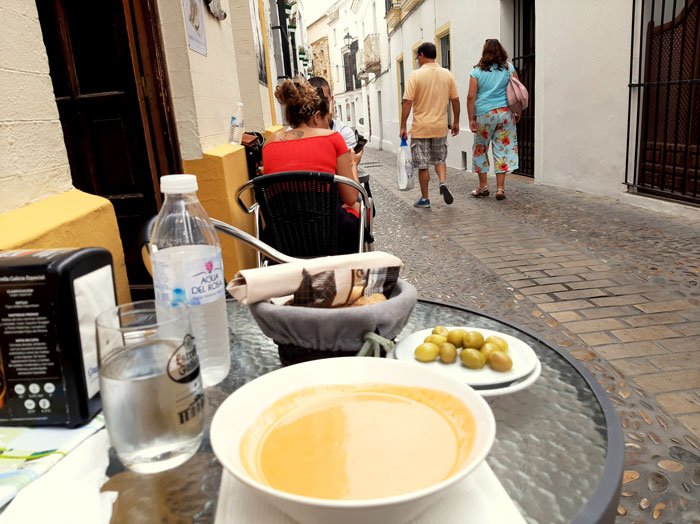
Anyway, this is where you should order all those Andalusian specialties – from the “gazpacho” and domestic olives, seafood “paella”, to “flan de la casa” dessert, accompanied by a glass of white wine. This is a must when it comes to Arcos de la Frontera Spain’s things-to-do list.
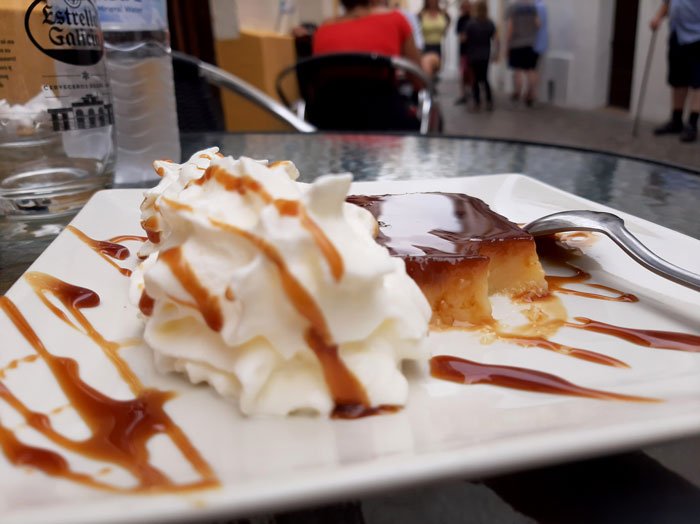
And when you go exploring the town, bear in mind that you should just keep following a straight line. Easier said than done in Arcos though. Here is why – one narrow street splits into two, three, or four, and if you continue to stroll along one of those, there will soon be another splitting the same way. Given that there are always tall (and always white) walls around you, dare to notice the difference! The only thing that you can be sure of is whether you are going down or up (neither lasts long), and that’s about it.
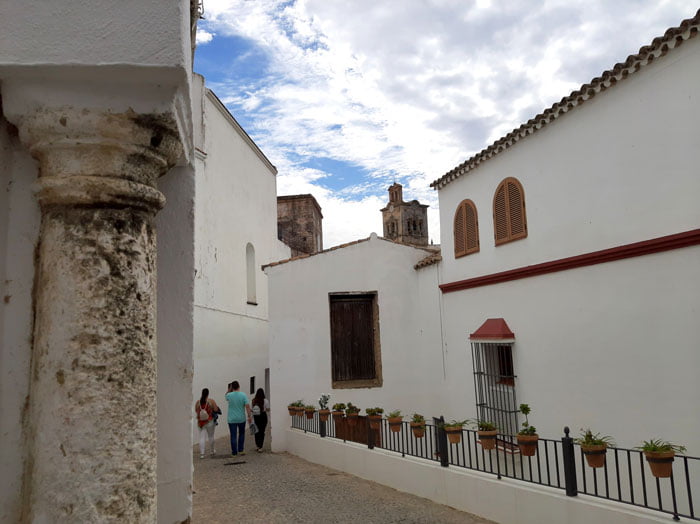
At some point, you will reach St Peter’s Church from the 16th century with an interesting façade. One can rest on the bench in front of it or at the surrounding typical tavernas.

According to the map, there are a couple more miradors to be found. One will provide a view from the cliff left of the Plaza del Cabildo, while the other is located on the opposite side of the town from this plaza. The first is pleasant with flowers under white arches, a wide terrace, and a beautiful view of the lake in the valley.
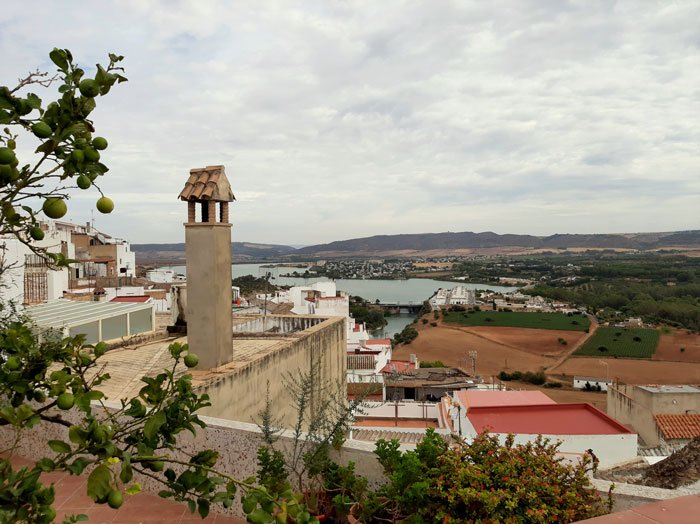
While strolling towards the other (and it so happened that I went far down the lower Arcos and was now climbing upwards), there are the remains of the 11th-century Arab wall to be seen, numerous steps between houses (where cars can’t go through, although one can never be certain here), and the Matrera Gate.
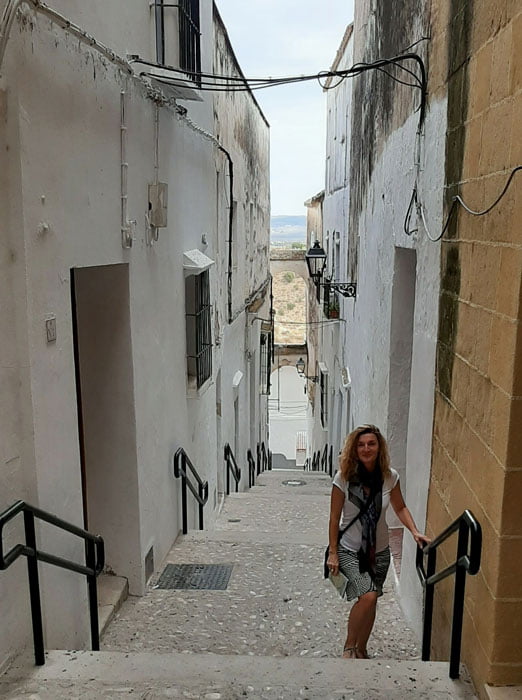
The gate connects Arcos with the lower town on this side and was very important for defending the settlement from the east. It once had four towers. When it was restored in the 17th and 18th centuries, a small chapel was added to the upper part of the gate. I stood there watching rare cars go through.
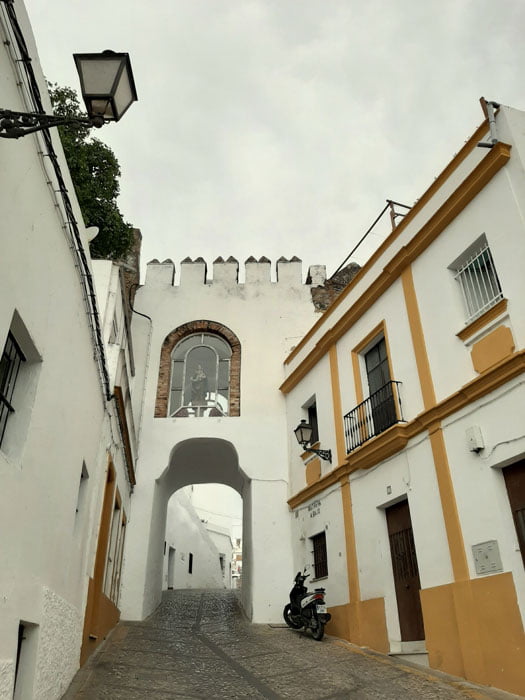
If you continue up the hill, there will be a street curving along the cliff, so that there is a nice view of the white village on its slopes, right above the river. This is when I decided to go all around the village because going among these white houses again will take me a few more hours to get to any familiar place in town.
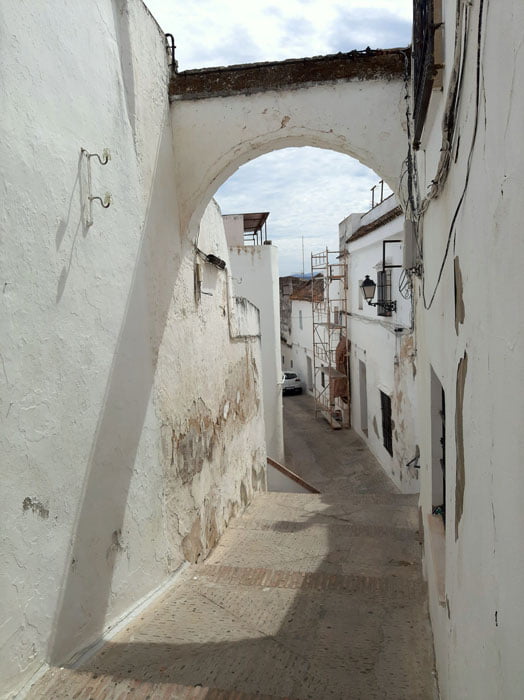
The last morning when I was supposed to leave Arcos (for Ronda), it was slightly raining. It was Sunday, and so the microbus didn’t work. The landlady offered to borrow her umbrella (“which I could leave with the lady at the station counter who was her friend” – a truly small place, no doubt about that). The cloud, fortunately, soon disappeared. The station was 30 minutes away.
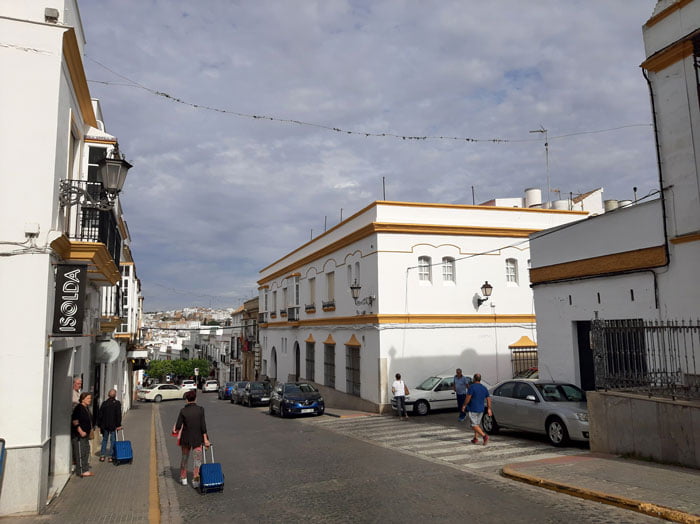
TIP: The easiest way to buy bus tickets would be online through the Spanish transportation company Comes. You just need to pick your destination, and the PDF of your ticket will be delivered by email, which is supposed to be shown to the bus driver.
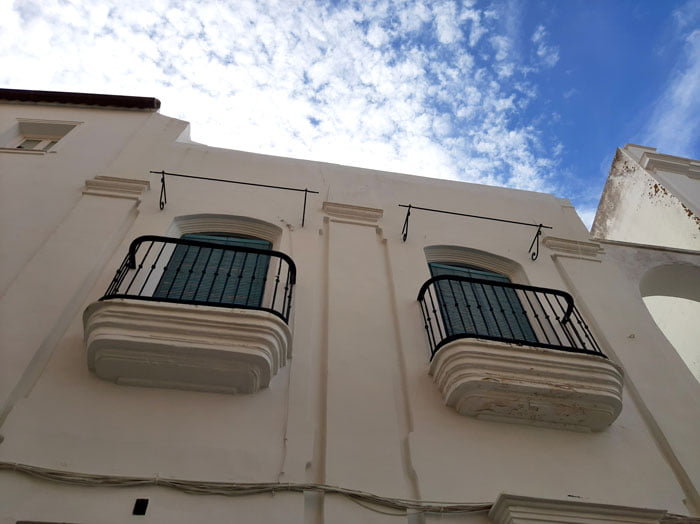
Still, I had some time left and wanted to have another coffee along with those delicious Andalusian cider cookies. There was a bar, almost full (even though it wasn’t even 10 am), where I peeked in and asked if they have coffee. A waiter who was pouring a draft beer turned towards me, and so did all the guests.
“No coffee”, he said.
“Some juice maybe instead?”, I asked.
“No juice.”
I am not really sure what my expression was like, but a few of those elderly guests holding their drinks came out to the street just to show me, waving their hands (and in Spanish, of course) that there was a hotel across the street “that served coffee and cookies”.
(By the way, the bus station counter was closed again, so I couldn’t have left that umbrella there after all.)
Next: EXCITING RONDA ANDALUSIA
The full ANDALUSIA series
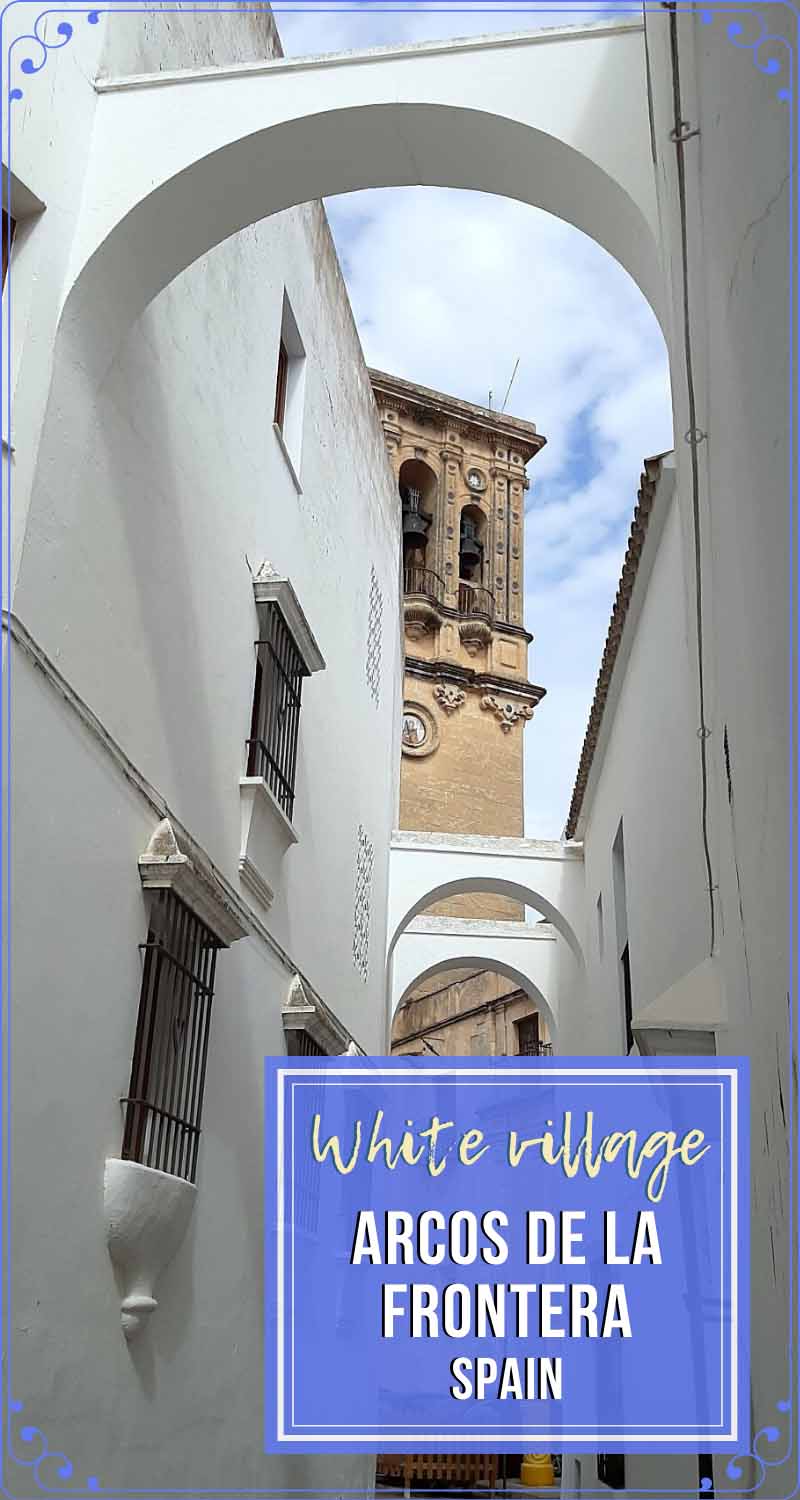
If you need a freelance travel writer or you would like to see your country, city, flight, etc., presented on the blog, drop me an email.
Find our more on Freelance Travel Writer page.
I am looking forward to working with you.




16 responses
Haha, you made me laugh with that bus anecdote, what an experience! By the way, love your photos. You really made me want to see this myself. Arcos is going up on my Spain-bucket-list. ❤️
Thank you so much. So glad the post made you laugh, the scene was surreal. 😀 It did make a nice memory though.
I know, Arcos was one of my favorite stops in Andalusia. <3
This is an amazing travel guides of andalucia. Its beautiful!
Thank you, so glad you like it. You’re welcome to browse around for more on Andalusia, there’s the whole series on the blog.
Cheers! 🙂
The flan looks delicious and the towns looks very white. i first heard of Andalucia in a Clash song. And later watched Rick steves there.
It’s just mesmerizing, I love this part of Spain. It’s worth visiting once in a lifetime.
Also, there are two towns I’d love to return to myself – Cordoba and this white village. 🙂
Thanks, Brian.
I had no idea abou the white villages! So beautiful. Reminds me a bit of Greece. Love to explore this area.
They are pretty popular in Andalusia with the true mixture of traditions and some genuine charm. And so true, they resemble those white-washed houses on Greek islands, even though with totally different stories behind them. 🙂
I love hills and bridges, so this looks like a place I will like. I will be in Spain in April, but sadly we only have time to see Madrid.
Such a pity. Andalusia is so unique and so different than the rest of Spain.
As for Arcos, the town itself is located on the edge of the cliff which makes it even more interesting.
those houses look extremely picturesque. they’re nothing special architecturally, but the tidy look, white paint and flower pots on the walls seem to work miracles 🙂
Yep, that’s the charm of the white village. 🙂
This looks Like it’s straight out of a fairy tale! So Beautiful.
Exactly. 🙂 Most of Andalusia is fairy-tale-like with all the castles and palaces. You are welcome to check out the full blog series, I’m sure you’ll be blown away by Granada and Cordoba.
Loved your photos and the story of riding the microbus. I studied in Spain a long time ago and we saw many towns in Andalusia.
Thank you for helping me remember the charm of those towns and their twisting narrow roads and many churches.
It must have been interesting to study here. So envious. 🙂
I’m just in love with the Moorish legacy and the architecture of Andalusia so much that I’d love to take another tour around the south of Spain. It’s mesmerizing.